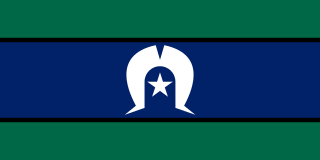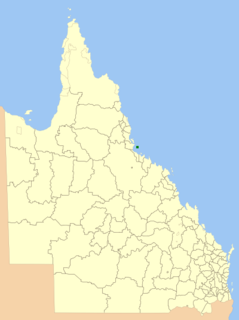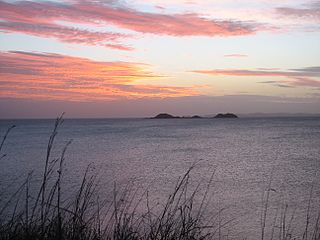
The Torres Strait Islands are a group of at least 274 small islands in the Torres Strait, a waterway separating far northern continental Australia's Cape York Peninsula and the island of New Guinea. They span an area of 48,000 km2 (19,000 sq mi), but their total land area is 566 km2 (219 sq mi).

Palm Island is a locality consisting of an island group of 16 islands, split between the Shire of Hinchinbrook and the Aboriginal Shire of Palm Island, in Queensland, Australia. The locality coincides with the geographical entity known as the Palm Island group, also known as the Greater Palm group, originally named the Palm Isles.

Aboriginal Australians are the various Indigenous peoples of the Australian mainland and many of its islands, such as Tasmania, Fraser Island, Hinchinbrook Island, the Tiwi Islands, and Groote Eylandt, but excluding the Torres Strait Islands. The term Indigenous Australians refers to Aboriginal Australians and Torres Strait Islanders collectively. It is generally used when both groups are included in the topic being addressed. Torres Strait Islanders are ethnically and culturally distinct, despite extensive cultural exchange with some of the Aboriginal groups. The Torres Strait Islands are mostly part of Queensland but have a separate governmental status.

Green Island is a marine island and locality in the Cairns Region, Queensland, Australia. In the 2016 census Green Island had a population of 25 people.

Fantome Island is one of the islands in the Palm Island group. It is neighboured by Great Palm Island and is 65 km (40 mi) north-east of Townsville, Queensland on the east coast of Australia. The island is small with an area of 7.8 km2 (3.01 sq mi) and is surrounded by a fringing reef. The Djabugay (Aboriginal) name for this island is Eumilli Island.

Eclipse Island, or Garoogubbee, once known as Punishment Island, is one of the small islands in the Palm Islands group off the coast of Queensland, Australia. The nearest island is Great Palm Island, after which the group is named. Along with nine of the other islands within the Palm Islands group, it falls under the local government area of the Aboriginal Shire of Palm Island.

Saibai Island is an island of the Torres Strait Islands archipelago, located in the Torres Strait of Queensland, Australia. The island is situated north of the Australian mainland and south of the island of New Guinea. The island is a locality within the Torres Strait Island Region local government area. The town of Saibai is located on the north-west coast of the island. According to the 2016 census, Saibai Island had a population of 465 people.

Moa Island, also called Banks Island, is an island of the Torres Strait Islands archipelago that is located 40 kilometres (25 mi) north of Thursday Island in the Banks Channel of Torres Strait, Queensland, Australia. It is also a locality within the Torres Strait Island Region local government area. This island is the largest within the "Near Western" group. It has two towns, Kubin on the south-west coast and St Pauls on the east coast, which are connected by bitumen and a gravel road. In the 2016 census, Moa Island had a population of 448 people.

Coconut Island, Poruma Island, or Puruma in the local language, is an island in the Great North East Channel near Cumberland Passage, Torres Strait, Queensland, Australia. One of the Torres Strait Islands, Coconut Island is 130 kilometres (81 mi) northeast of Thursday Island. Administratively, Coconut Island is a town and Poruma Island is the locality within the Shire of Torres.

The Aboriginal Shire of Palm Island is a special local government area of Queensland, Australia, managed by the Palm Island Aboriginal Shire Council under a Deed of Grant in Trust granted to the community on 27 October 1986. The local council was previously the Palm Island Community Council, which had far fewer powers. The shire is located on the Palm Island group, off the north Queensland coast near the city of Townsville.
The Manbarra, otherwise known as the Wulgurukaba, are Aboriginal Australian people, and the traditional custodians of the Palm Islands, Magnetic Island, and an area of mainland Queensland to the west of Townsville.
Indigenous Australians are people with familial heritage to groups that lived in Australia before British colonisation. They include the Aboriginal and Torres Strait Islander peoples of Australia. The term Aboriginal and Torres Strait Islander peoples or the person's specific cultural group, is often preferred, though the terms First Nations of Australia, First Peoples of Australia and First Australians are also increasingly common.

The Northern Peninsula Area Region is a local government area in Far North Queensland, Australia, covering areas on the northwestern coast of Cape York Peninsula. It was created in March 2008 out of three Aboriginal Shires and two autonomous Island Councils during a period of statewide local government reform. In June 2018, the area had a population of 3,069.

Great Palm Island, usually known as Palm Island, is the largest island in the Palm Islands group off Northern Queensland, Australia. It is known for its Aboriginal community, the legacy of an Aboriginal reserve, the Palm Island Aboriginal Settlement. The original inhabitants of the island were the Manbarra people, also known as the Wulgurukaba, who were removed to the mainland by the Queensland Government in the 1890s. The island is also sometimes referred to as Bwgcolman, which is the name given to the Aboriginal and Torres Strait Islander people from disparate groups who were deported from many areas of Queensland to the reserve in 1918, and their descendants.
Indigenous land rights in Australia, also known as Aboriginal land rights in Australia, relate to the rights and interests in land of Aboriginal and Torres Strait Islander people in Australia, and the term may also include the struggle for those rights. Connection to the land and waters is vital in Australian Aboriginal culture and to that of Torres Strait Islander people, and there has been a long battle to gain legal and moral recognition of ownership of the lands and waters occupied by the many peoples prior to colonisation of Australia starting in 1788, and the annexation of the Torres Strait Islands by the colony of Queensland in the 1870s.

The Quandamooka people are Aboriginal Australians who live around Moreton Bay in Southeastern Queensland. They are composed of three distinct tribes, the Nunukul, the Goenpul and the Ngugi, and they live primarily on Moreton and North Stradbroke Islands, that form the eastern side of the bay. Many of them were pushed out of their lands when the English colonial government established a penal colony near there in 1824. Each group has its own language. A number of local food sources are utilised by the tribes.

Umagico is a town and coastal locality in the Northern Peninsula Area Region, Queensland, Australia. In the 2016 census, Umagico had a population of 427 people.

South Mission Beach is a coastal town and locality in the Cassowary Coast Region, Queensland, Australia. In the 2016 census, South Mission Beach had a population of 932 people.

Roslyn Betty Poignant was an Australian photographic anthropologist who collaboratively published, interpreted, and repatriated her husband Axel Poignant's photos of indigenous peoples from Arnhem Land, Papua New Guinea, and Tahiti. Poignant was involved in photographing and writing about museum collections of the material culture of Polynesia, Melanesia, Micronesia, and Australia. Poignant is known for her finding, researching and repatriating an 1885 photograph taken in Paris by anthropological photographer Roland Bonaparte of three Queensland indigenous persons taken to form part of an international touring troupe, for P. T. Barnum's circus. These were people presumed lost to the Manbarra of Palm Island

Palm Island Aboriginal Settlement, later officially known as Director of Native Affairs Office, Palm Island and also known as Palm Island Aboriginal Reserve, Palm Island mission and Palm Island Dormitory, was an Aboriginal reserve and penal settlement on Great Palm Island, the main island in the Palm Island group in North Queensland, Australia. It was the largest and most punitive reserve in Queensland.
 Text may have been copied from this source, which is available under a Attribution 4.0 International (CC BY 4.0) licence.
Text may have been copied from this source, which is available under a Attribution 4.0 International (CC BY 4.0) licence.













